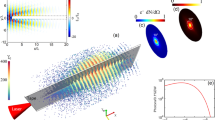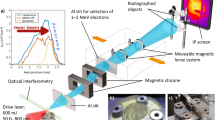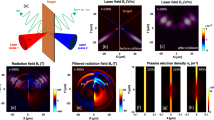Abstract
Brilliant X- and γ-ray sources with ultrashort duration are widely pursued in fundamental science, industry and medicine. Compact femtosecond X-ray sources based on relativistic electrons accelerated by the laser wakefield in gases have performed outstandingly. Their energy conversion efficiency from laser to hard X-ray photons (>10 keV) is, however, limited to 10−7–10−5. Here we report the high-yield generation of hard X-ray flashes from targets made of carbon nanotubes, instead of gases. Orders-of-magnitude more electrons, accelerated to relativistic energy, are strongly wiggled inside a micrometre-scale, near-critical density plasma formed by the nanotube target, emitting 1012 high-energy photons per shot. The yield of hard X-rays exceeds 1010 photons per joule, corresponding to an unprecedented efficiency of 10−3. Irradiated by upcoming 10-PW-class lasers, such targets can deliver 10-MeV photons with brightness outperforming existing sources by two orders of magnitude.
This is a preview of subscription content, access via your institution
Access options
Access Nature and 54 other Nature Portfolio journals
Get Nature+, our best-value online-access subscription
$29.99 / 30 days
cancel any time
Subscribe to this journal
Receive 12 print issues and online access
$209.00 per year
only $17.42 per issue
Buy this article
- Purchase on Springer Link
- Instant access to full article PDF
Prices may be subject to local taxes which are calculated during checkout





Similar content being viewed by others
Data availability
The main data that support the findings of this study are available within the paper and its Supplementary Information. Extra data are available from the corresponding authors upon request.
Code availability
The open-source code EPOCH was used and the detailed set-up of the simulations that support the plots and other findings of this study are presented in the Supplementary Information.
References
Albert, F. L. & Thomas, A. G. R. Applications of laser wakefield accelerator-based light sources. Plasma Phys. Control. Fusion 58, 103001 (2016).
Wang, W. et al. Free-electron lasing at 27 nanometres based on a laser wakefield accelerator. Nature 595, 516–520 (2021).
Phuoc, K. T. et al. All-optical Compton gamma-ray source. Nat. Photon. 6, 308–311 (2012).
Powers, N. et al. Quasi-monoenergetic and tunable X-rays from a laser-driven Compton light source. Nat. Photon. 8, 28–31 (2014).
Sarri, G. et al. Ultrahigh brilliance multi-Mev γ-ray beams from nonlinear relativistic Thomson scattering. Phys. Rev. Lett. 113, 224801 (2014).
Khrennikov, K. et al. Tunable all-optical quasimonochromatic Thomson X-ray source in the nonlinear regime. Phys. Rev. Lett. 114, 195003 (2015).
Tsai, H. E. et al. Compact tunable Compton X-ray source from laser-plasma accelerator and plasma mirror. Phys. Plasmas 22, 023106 (2015).
Yu, C. et al. Ultrahigh brilliance quasi-monochromatic MeV γ-rays based on self- synchronized all-optical Compton scattering. Sci. Rep. 6, 29518 (2016).
Cole, J. M. et al. Experimental evidence of radiation reaction in the collision of a high-intensity laser pulse with a laser-wakefield accelerated electron beam. Phys. Rev. X 8, 011020 (2018).
Zhu, C. et al. Inverse Compton scattering X-ray source from laser electron accelerator in pure nitrogen with 15-TW laser pulses. Plasma Phys. Control. Fusion 61, 024001 (2019).
Poder, K. et al. Experimental signatures of the quantum nature of radiation reaction in the field of an ultraintense laser. Phys. Rev. X 8, 031004 (2018).
Kneip, S. et al. Observation of synchrotron radiation from electrons accelerated in a petawatt-laser-generated plasma cavity. Phys. Rev. Lett. 100, 105006 (2008).
Cipiccia, S. et al. Gamma-rays from harmonically resonant betatron oscillations in a plasma wake. Nat. Phys. 7, 867–871 (2011).
Wang, X. et al. Quasi-monoenergetic laser-plasma acceleration of electrons to 2 GeV. Nat. Commun. 4, 1988 (2013).
Cole, J. M. et al. Laser-wakefield accelerators as hard X-ray sources for 3D medical imaging of human bone. Sci. Rep. 5, 13244 (2015).
Corde, S. et al. Femtosecond X-rays from laser-plasma accelerators. Rev. Mod. Phys. 85, 1–48 (2013).
Huang, T. W. et al. Highly efficient laser-driven Compton gamma-ray source. New J. Phys. 21, 013008 (2019).
Sylla, F. et al. Anticorrelation between ion acceleration and nonlinear coherent structures from laser-underdense plasma interaction. Phys. Rev. Lett. 108, 115003 (2012).
Chen, S. N. et al. Density and temperature characterization of long-scale length, near-critical density controlled plasma produced from ultra-low density plastic foam. Sci. Rep. 6, 21495 (2016).
Wang, P. et al. Fabrication of large-area uniform carbon nanotube foams as near-critical-density targets for laser-plasma experiments. High Power Laser Sci. Eng. 9, e29 (2021).
Choi, I. W. et al. Highly efficient double plasma mirror producing ultrahigh-contrast multi-petawatt laser pulses. Opt. Lett. 45, 6342–6345 (2020).
Bin, J. et al. Enhanced laser-driven ion acceleration by superponderomotive electrons generated from near-critical-density plasma. Phys. Rev. Lett. 120, 074801 (2018).
Di Piazza, A. et al. Extremely high-intensity laser interactions with fundamental quantum systems. Rev. Mod. Phys. 84, 1177 (2012).
Ostermayr, T. M. et al. Laser-driven X-ray and proton micro-source and application to simultaneous single-shot bi-modal radiographic imaging. Nat. Commun. 11, 6174 (2020).
Cipiccia, S. et al. A tuneable ultra-compact high-power, ultra-short pulsed, bright gamma-ray source based on bremsstrahlung radiation from laser-plasma accelerated electrons. J. Appl. Phys. 111, 063302 (2012).
Günther, M. et al. Forward-looking insights in laser-generated ultra-intense γ-ray and neutron sources for nuclear application and science. Nat. Commun. 13, 170 (2022).
Benedetti, A. et al. Giant collimated gamma-ray flashes. Nat. Photon. 12, 319–323 (2018).
Sampath, A. et al. Extremely dense gamma-ray pulses in electron beam-multifoil collisions. Phys. Rev. Lett. 126, 64801 (2021).
Mourou, G. et al. The future is fibre accelerators. Nat. Photon. 7, 258–261 (2013).
Fu, C., Zhang, G. & Ma, Y. New opportunities for nuclear and atomic physics on the femto- to nanometer scale with ultra-high-intensity lasers. Matter Radiat. Extrem. 7, 024201 (2022).
Rio, M. S. D. & Dejus, R. J. XOP v2.4: recent developments of the X-ray optics software toolkit. Proc. SPIE 8141, 814115 (2011).
Bohlen, T. T. et al. The FLUKA code: developments and challenges for high energy and medical applications. Nucl. Data Sheets 120, 211–214 (2014).
Bonnet, T. et al. Response functions of imaging plates to photons, electrons and 4He particles. Rev. Sci. Instrum. 84, 103510 (2013).
Arber, T. D. et al. Contemporary particle-in-cell approach to laser-plasma modelling. Plasma Phys. Control. Fusion 57, 113001 (2015).
Acknowledgements
The work was supported by the Institute for Basic Science, Korea under project code IBS-R012-D1, and the National Grand Instrument Project, China (2019YFF01014402). W.M. acknowledges support from the National Science Fund for Distinguished Young Scholars (12225501). W.M. and X.Y. thank the NSFC innovation group project (11921006) for financial support. X.Y. acknowledges support from the National Natural Science Foundation of China (11025523 and J1103206). The PIC simulations were carried out in Shanghai Super Computation Center and the High-performance Computing Platform of Peking University. We thank H. Deng for fruitful discussions.
Author information
Authors and Affiliations
Contributions
W.M., X.Y. and C.H.N. conducted the work. The experiments were performed by Y.S., P.W., S.G.L., Y.J.R., H.W.L., J.W.Y., J.H.S., S.K.L., Z.P., D.K., Z.M., J.L., S.X. and I.W.C. Y.S. carried out all simulations. Some details of the physics were clarified by Z.D., W.Z. and T.T. The manuscript was written by Y.S. and revised by W.M. All authors reviewed the manuscript.
Corresponding authors
Ethics declarations
Competing interests
The authors declare no competing interests.
Peer review
Peer review information
Nature Photonics thanks Tobias Ostermayr, Ingo Uschmann and the other, anonymous, reviewer(s) for their contribution to the peer review of this work.
Additional information
Publisher’s note Springer Nature remains neutral with regard to jurisdictional claims in published maps and institutional affiliations.
Supplementary information
Supplementary Information
Supplementary Figs. 1–25, Tables 1–7 and Sections I–V.
Rights and permissions
Springer Nature or its licensor (e.g. a society or other partner) holds exclusive rights to this article under a publishing agreement with the author(s) or other rightsholder(s); author self-archiving of the accepted manuscript version of this article is solely governed by the terms of such publishing agreement and applicable law.
About this article
Cite this article
Shou, Y., Wang, P., Lee, S.G. et al. Brilliant femtosecond-laser-driven hard X-ray flashes from carbon nanotube plasma. Nat. Photon. 17, 137–142 (2023). https://doi.org/10.1038/s41566-022-01114-8
Received:
Accepted:
Published:
Issue Date:
DOI: https://doi.org/10.1038/s41566-022-01114-8
This article is cited by
-
High-flux bright x-ray source from femtosecond laser-irradiated microtapes
Communications Physics (2024)
-
Lighting up a nest for X-ray emission
Nature Photonics (2023)
-
Time-resolved optical shadowgraphy of solid hydrogen jets as a testbed to benchmark particle-in-cell simulations
Communications Physics (2023)
-
Carbon nanotubes as outstanding targets for laser-driven particle acceleration
Nano Research (2023)
-
Spatial and spectral measurement of laser-driven protons through radioactivation
Nuclear Science and Techniques (2023)



